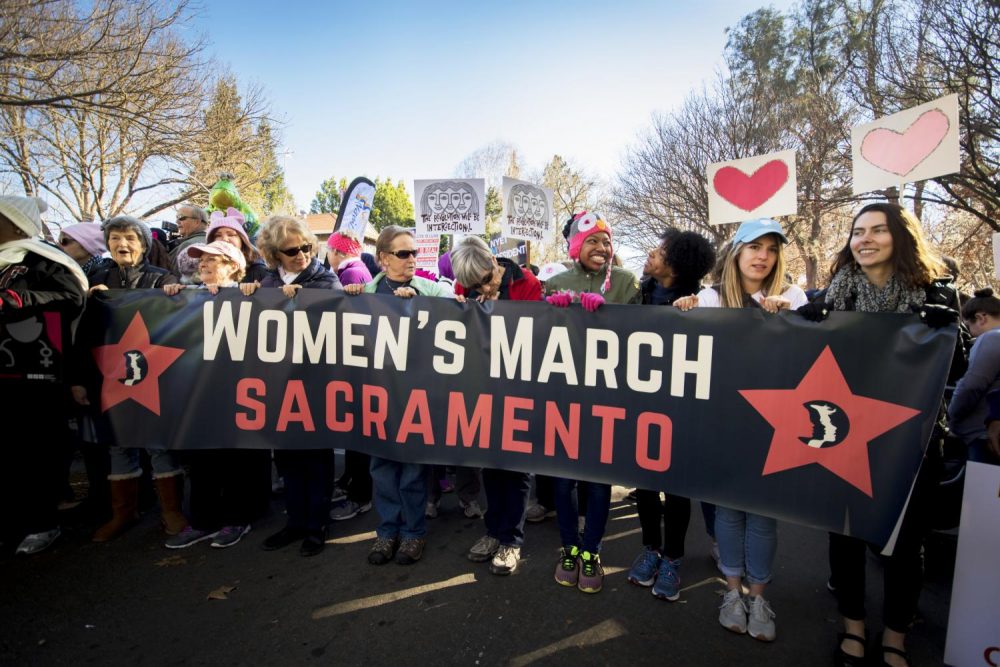Millions of protesters took to the streets of cities all across the country, including Sacramento, to voice their support for the rights of marginalized populations in the United States on Saturday as part of a national demonstration of equality.
While the march was officially called a “Women’s March,” protesters used the event to stage their concerns about issues ranging from the ending of the DACA program to their unhappiness with current education policy.
The organized protests were part of the second annual Women’s March, which started in 2017 in response to the election of President Donald Trump.
The Sacramento march began at 11 a.m. at Southside Park and thousands of people in attendance marched north up 5th St., down the Capitol Mall and eventually stopped at the west steps of the capitol building with a crowd 16,000 people stronger than last year’s march—an estimated 36,000 according to the march’s Youth Director Xochitl Hermosillo.
Saturday’s crowd is estimated to have peaked at over 30,000 people in the streets of Sacramento—10,000 more people than showed up to last year’s march.
Mayor Darrell Steinberg walked with protesters as they chanted: “This is what democracy looks like,” and held up signs reading slogans like: “Keep the kids, deport the racists,” or “Women’s rights are human rights.”
News helicopters patrolled the skies around the Capitol Park grounds trying to capture the massive crowd as they inched their way towards the Capitol.
“I’m fed-up with the craziness. I don’t understand how people say we have equal rights. My DACA students and immigrant students don’t have equal rights. Particularly my Muslim students. The hatred they experience every single day should not be tolerated by anyone. We have to help people whenever we can. That’s why I’m here. I’m here to help.”
-American River College Professor Ally Joy
Once at the Capitol, a rally was held featuring speeches from Steinberg, Councilwoman Angelique Ashby and the founders of We Said Enough, a campaign started in order to overhaul how sexual harassment is reported and treated in the workplace.
While most of the protesters were there to support women’s overall equality, some picketers like artist Daniel Alejandro Trejo took it upon themselves to represent communities they felt were particularly vulnerable or at-risk of having their voices go unheard.
“Given the current political climate, I need to be here. Undocumented women need a voice, because I think their plight sometimes gets overshadowed,” Trejo said. “With Trump ending programs that these people depend on just to survive, I can’t sit back and do nothing.”
Trejo wasn’t the only person in attendance representing marginalized populations of women, members of the Los Rios College Federation of Teachers were there supporting their students.
LRCFT member and American River College Professor Andrea Garvey said she was there to support the undocumented immigrants and other vulnerable student populations.
“I’m here for our DACA students, for the LGBT students and other marginalized groups,” Garvey said. “I’m here to represent their voices and I know my colleagues are here to do the same for their students.”
English as a Second Language Professor and ARC instructor Ally Joy echoed the sentiment, citing her work with foreign-born students as a key reason for her attending the march.
“I’m fed-up with the craziness. I don’t understand how people say we have equal rights. My DACA students and immigrant students don’t have equal rights. Particularly my Muslim students,” Joy said. “The hatred they experience every single day should not be tolerated by anyone. We have to help people whenever we can. That’s why I’m here. I’m here to help.”








![“I feel like it could ultimately depend on how you use it. AI could be a great resource if you have a question or if you need a quick reminder of something or [...] if you need ideas. But if you’re using it to copy or take other people’s credit for something you didn’t do, I feel like that’s something that really discouraged a lot of people from using it.” Hope Kue | General Science (Photo by Cameron Duncan)](https://www.arcurrent.com/wp-content/uploads/2025/08/hope-1200x800.jpg)


